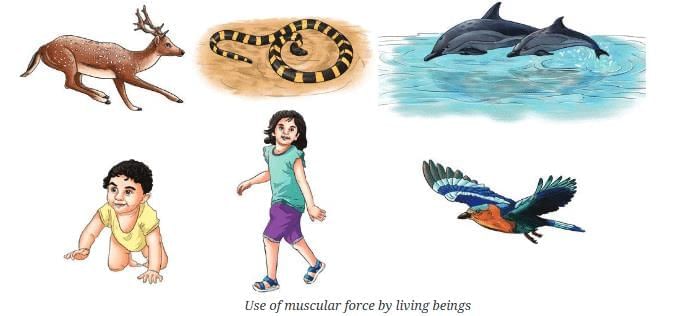Exploring Forces Chapter Notes | Chapter Notes For Class 8 PDF Download
Introduction
Have you ever wondered why cycling uphill feels like a much tougher workout, but when you’re coming downhill, your cycle seems to almost zoom forward on its own? These are all questions about something invisible but powerful—forces acting on us and the things around us.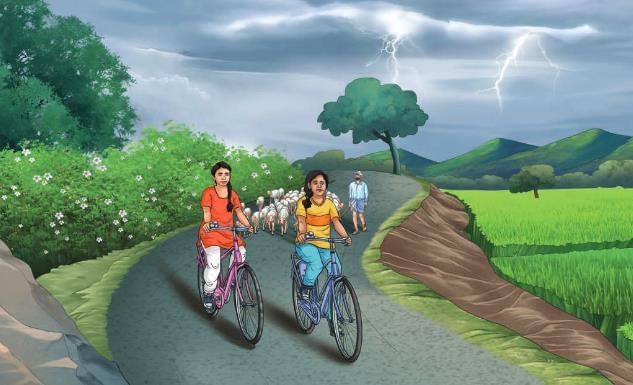
Imagine Sonali and Ragini, two friends setting out for an adventure on their bicycles during the summer holidays. As they cycle against a strong wind, struggle up rough and hilly paths, and then speed down effortlessly without pedaling, they are experiencing different kinds of forces. Even nature seems to join in—with wind pushing them, the ground offering resistance, and finally, gravity pulling them down the hill.
What are these forces? What makes it hard or easy to move in different situations?
Let us get ready to explore and find out what’s really happening when you push, pull, slip, slide or speed up and slow down.
What Is a Force?
Understanding Force through Activity
- Take a large cardboard box.
- Try to move the box in as many different ways as possible—push it, pull it, slide it, drag it, or roll it.
- Notice: In every method you use, you are either pushing or pulling the box.
 a) Pushing b) Pulling and c) Lifting
a) Pushing b) Pulling and c) Lifting
Definition: In science, a force is simply a push or a pull applied to an object. Anytime you move, stop, or change the direction or shape of an object, you are using a force.
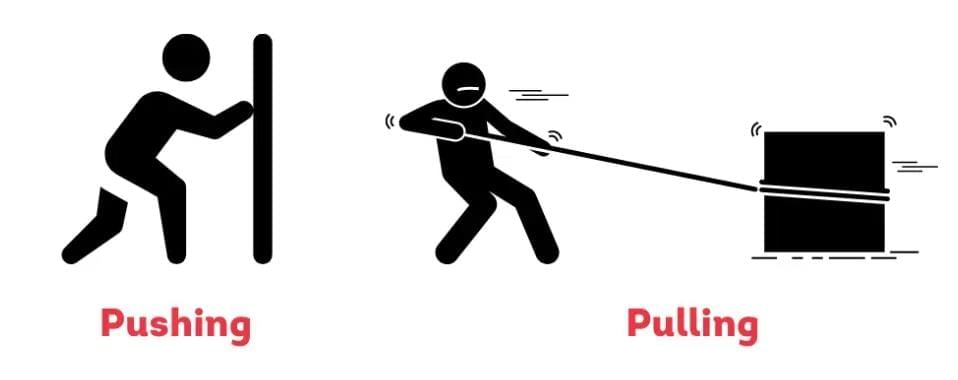
- Force can be a push: For example, when you push a swing away from you.
- Force can be a pull: For example, when you draw water from a well using a rope.
- No matter how you chose to move the box (from the activity)—by dragging, sliding, rolling, lifting, etc.—some form of push or pull is always involved.
What Can a Force Do to the Bodies on Which It Is Applied?
We experience forces all the time, often without noticing. Let’s explore real-life situations to see what a force can do:
- Holding a moving bicycle from behind to stop: A pull force stops or slows down the bicycle.
- Hitting a moving ball with a bat: A push force changes the direction of the moving ball.
- Pressing an inflated balloon: A push force changes the shape of the balloon.
- Kicking a football: A push force moves the football from rest, starting its motion.
- Applying brakes on a moving cycle: A push force slows down or stops the cycle.
- Stretching a rubber band: A pull force changes the shape of the rubber band.
- Rolling a chapati: A push force changes the shape of the dough.
- Turning the steering handle of an autorickshaw: A push or pull force changes the direction of the autorickshaw.
- Opening a drawer: A pull force moves the drawer out from rest.
- Stopping a cricket ball (fielder catches it): A push force stops or slows down the ball.
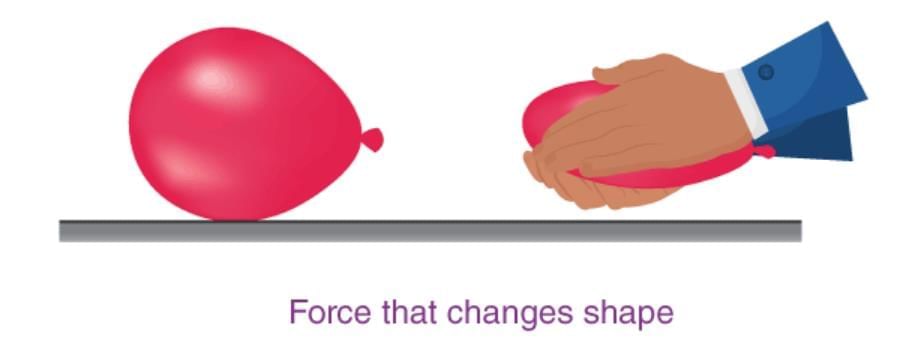 Application of Force
Application of Force
From the above examples, we see that the application of force can:
- Start or move an object at rest (e.g. push a stationary object)
- Stop or slow down a moving object (e.g. catch a moving ball, apply brakes)
- Change the speed of a moving object (e.g. push a swing harder to go faster)
- Change the direction of a moving object (e.g. hit a cricket ball to send it in another direction)
- Change the shape of an object (e.g. squeeze, stretch, roll, twist)
In summary: A force can make an object move, stop, speed up, slow down, change direction, or change its shape
Are Forces an Interaction Between Two or More Objects?
Whenever you push or pull something, there are always two objects involved.
- Example 1: Your hand and the table when you push a table.
- Example 2: The bat and the moving ball.
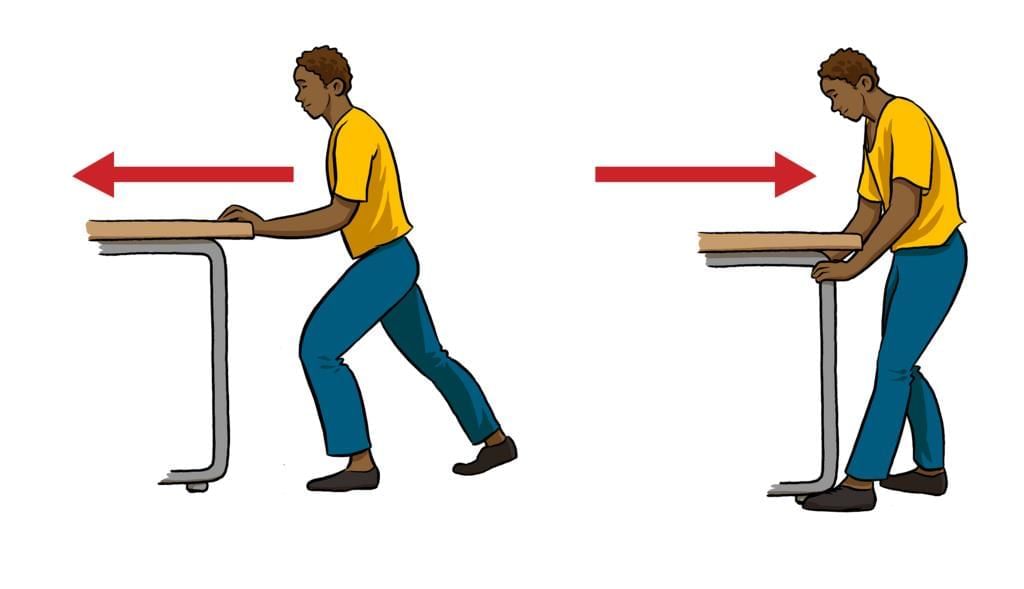 Forces are the result of interactions between two or more objects.
Forces are the result of interactions between two or more objects.
A force is a push or pull on an object resulting from its interaction with another object. The SI unit (international scientific unit) for measuring force is the newton(symbol: N).
Is Force Needed for Change?
- Every change in speed, direction, or shape of an object means that a force has acted.
- If nothing is changing (object at rest, no change in speed/direction/shape), either there is no force, or the forces acting are balanced.
- If an object is at rest, it doesn’t mean no force is acting—it means forces are balanced.
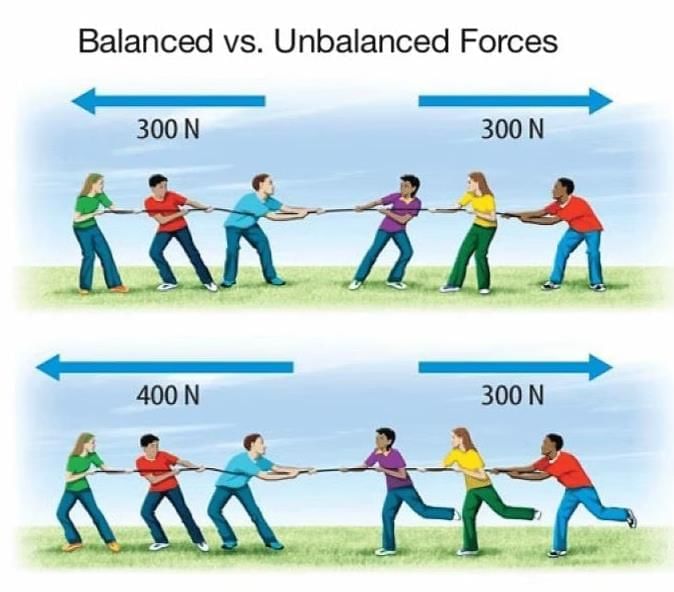
SI Unit of Force
- The SI unit (international scientific unit) for measuring force is the newton(symbol: N).
- 1 newton is the amount of force needed to give a 1 kg object an acceleration of 1 meter per second squared.
Forces Always Work in Pairs
- When you apply a force on another object, you will feel a force back on yourself as well.
- Example: When pushing a table, your hand feels a resistance.
- As soon as the interaction stops, the force disappears for both.
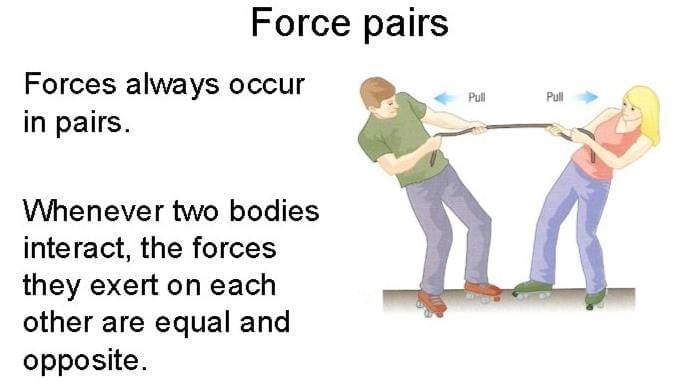
What Are the Different Types of Forces?
Forces can be divided into two main categories:
- Contact Forces
- Non-contact Forces
Contact Forces
Forces which act only when there is physical contact between the objects are called contact forces.1. Muscular Force
The force applied by the action of muscles in humans and animals. All movement we do—walking, lifting, pushing, pulling, chewing, even our heartbeat—uses muscular force.
Examples:
- Lifting a bag, kicking a football, chewing food, pumping blood (heart muscle).
- Animals and humans have used animal muscular force for tasks like pulling carts or turning wheels.
- This force only acts when a person or animal is in direct (or indirect, through a tool) contact with the object.
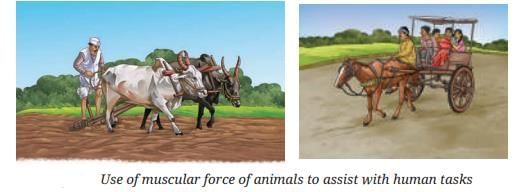
2. Friction (Force of Friction)
Friction is a force that opposes the motion of an object when it moves or tries to move over another surface. It acts in the opposite direction to the motion.
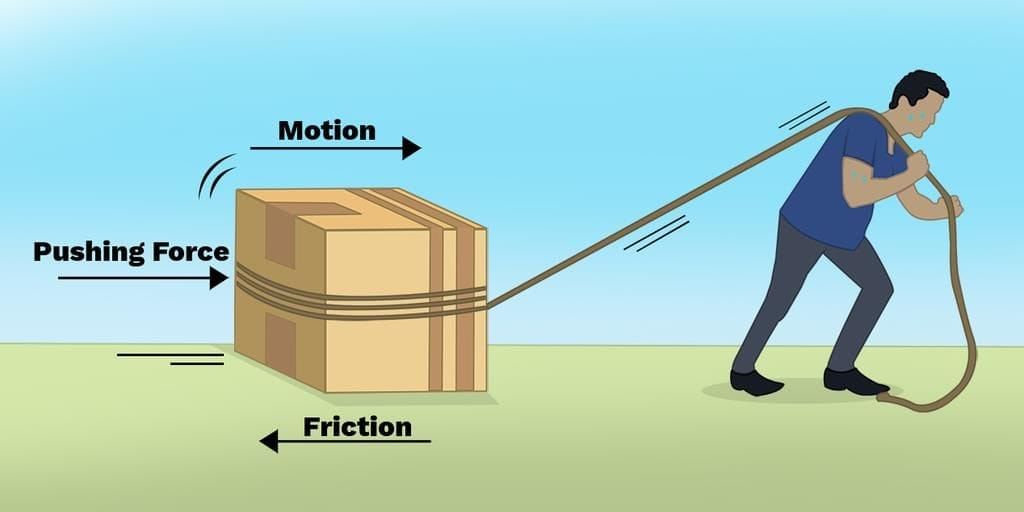 Frictional Force
Frictional Force
- How friction works: Arises because of tiny irregularities in the surfaces—these irregularities “lock” together and resist motion.
- When you push a box on the table, it stops after a while because friction between the box and table slows it down and brings it to rest.

- Nature of Surfaces: Friction changes on different surfaces—rougher surfaces (like sandpaper or cloth) have more friction than smoother ones (like glass or ceramic tile). This is why a box stops more quickly on rough surfaces.
- Friction in air and water: Air and water also create friction called drag or air resistance (for airplanes, cars, boats). This is why these vehicles are designed to be streamlined—to reduce friction.
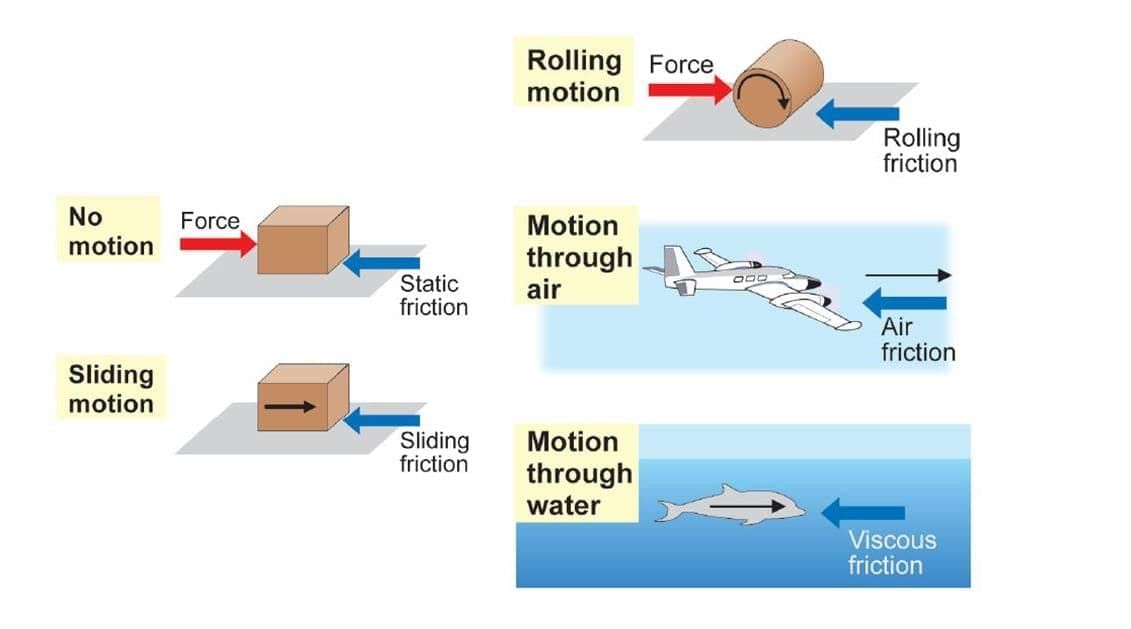
- Friction is a contact force because it only acts when two surfaces are in contact.
Non-contact Forces
There are forces whose effect can be experienced even if the objects are not in contact. These forces are called non-contact forces.
1. Magnetic Force
The force exerted by a magnet on magnetic materials (like iron) or another magnet, at a distance.
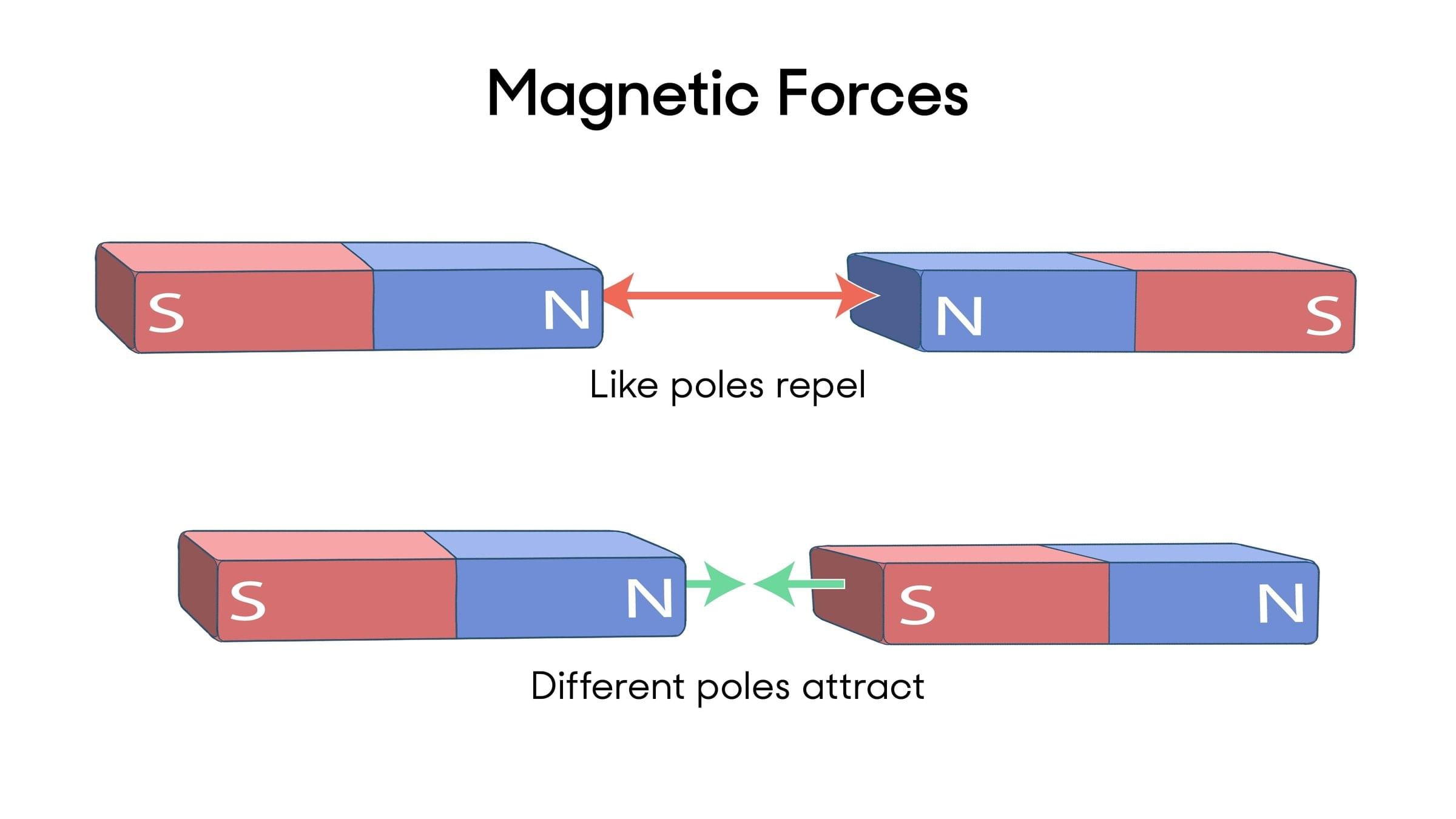
- If like poles of two ring magnets are brought close (north-north or south-south), they repel; if unlike, they attract. You can “float” one ring magnet above another if like poles are facing.
- This is a non-contact force since magnets don't have to touch to attract or repel.
2. Electrostatic Force
- When two objects of certain materials are rubbed together, electrical charges build up on their surfaces. These charges are called static charges as they do not move by themselves.
- The object that acquires static charges is said to be a charged object
The force exerted by a charged body on another charged body or an uncharged body is called electrostatic force. It is a non-contact force.
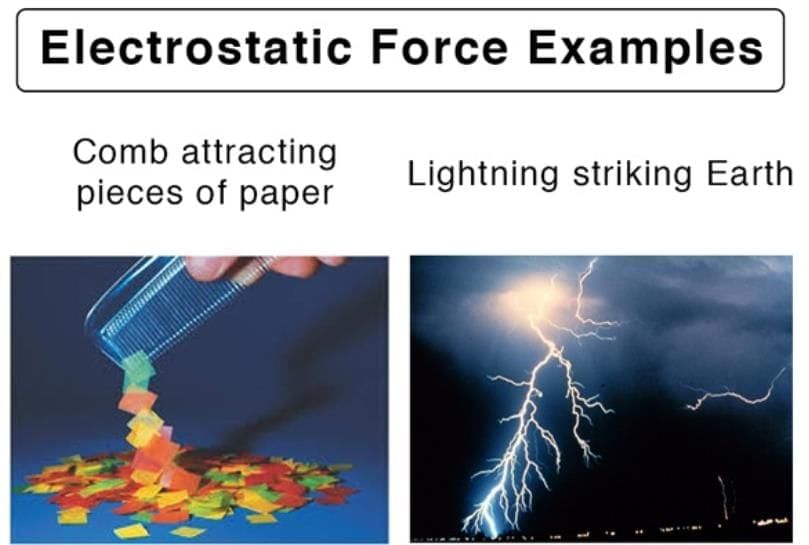
Examples:
- Rubbing a plastic scale with polythene: The charged scale attracts paper bits.
- Rubbing two balloons with wool and hanging them: The similarly-charged balloons repel each other; a charged balloon and the wool attract each other.
- Explanation: When certain materials are rubbed, they gain static charges (positive or negative). Like charges repel; unlike charges attract.
- When the charges move, they constitute an electric current in an electrical circuit. It is the same current which makes a lamp glow or generates a heating effect or a magnetic effect.
Gravitational Force
The force with which the Earth attracts objects towards itself is called the gravitational force. The gravitational force exerted by the Earth is also called force of gravity or simply gravity.
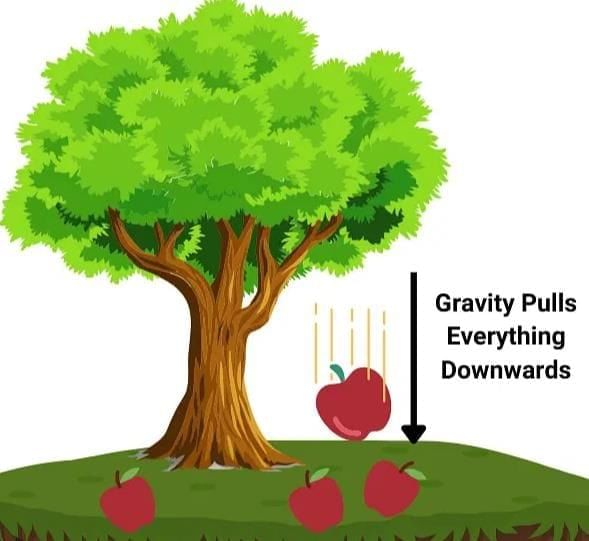
- If you throw a ball up, no matter how hard, it always comes down to the ground. This is gravity pulling it down.
- Always attractive (never repulsive—unlike magnetic or electrostatic).
- Acts between any objects with mass (not just Earth—you’ll learn more about universal gravitation in higher classes!).
- While going up, the speed of the object goes on decreasing till the object comes to a stop, its direction of motion changes and while coming down the speed goes on increasing.
- We say that the object undergoes a vertical motion when it moves in a vertical direction under the influence of the gravitational force.
- Gravitational force works at a distance and needs no contact.
Weight and Its Measurement
Weight is the force with which the Earth pulls an object towards itself due to gravity.
- Weight measures how strongly Earth attracts an object.
- SI unit of weight: newton (N), the same as force.
Measuring Weight with a Spring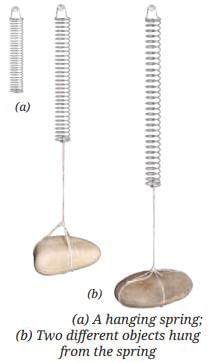
- When you suspend an object from a spring, the spring stretches due to the force with which the Earth pulls (the weight of the object).
- If you hang different-mass objects one after another, each causes a different amount of stretching.
- This proves that heavier objects are pulled with more force—the weight of an object depends on its mass; heavier objects have greater weight.
Spring Balance: Measuring Force (Weight) with a Device
- Spring balance: A tool with a spring fixed at one end and a hook at the other. The amount the spring stretches tells you the force (weight) applied (by the hanging object).
- Scale markings: Usually shown in newtons (N) for weight, and also in grams/kilograms for mass when used on the Earth.
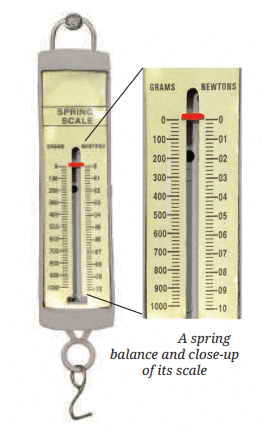
- Observing Maximum Weight Measurable (Range): The range of a spring balance is the maximum weight it can measure. If a spring balance shows values from 0 to 10 N, its range is 0–10 N, meaning it can measure weights up to 10 N.
Determining the Smallest Readable Value (Least Count) of a Spring Balance: The least count of a spring balance is the smallest difference in weight it can measure. It is calculated by dividing the difference between two major marks by the number of divisions between them.
Example: If 1 N is divided into 5 small marks, each small mark is 0.2 N.
This tells us the spring balance can measure changes as small as 0.2 N.Measuring Weight with a Spring Balance: To measure the weight of an object, hang it from the hook of a spring balance (without exceeding its maximum range). The pointer or reading on the scale shows the object’s weight in newtons. This method can be repeated for many objects, and results should be recorded in a table.
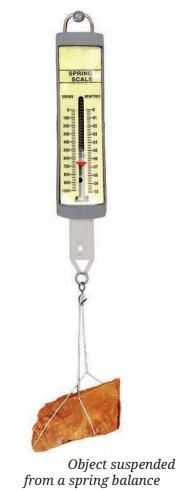
Using Spring Balance to Measure Mass: The mass scale (in g/kg) on a spring balance assumes Earth’s gravity:
The mass reading is only correct on Earth where gravitational acceleration is standard. Some balances also allow comparing an unknown object to an object with known mass (using beam balance).
Mass vs. Weight
Mass is the amount of matter in an object.- Measured in grams (g) or kilograms (kg).
- Stays the same at every place, whether on Earth, Moon, or any other planet.
Weight is the force with which Earth (or another planet) pulls an object.
- Measured in newtons (N).
- Calculated as:
Weight = Mass × Acceleration due to gravity (9.8m/s2 ) - Weight can change if the object is taken to another planet or if the gravitational force varies.
Variation of Weight on Different Planets:
(For an object with mass 1 kg)
| Planet | Mass (kg) | Weight (N) |
|---|---|---|
| Earth | 1 | 10 |
| Moon | 1 | 1.6 |
| Mars | 1 | 3.8 |
| Venus | 1 | 9 |
| Jupiter | 1 | 25.4 |
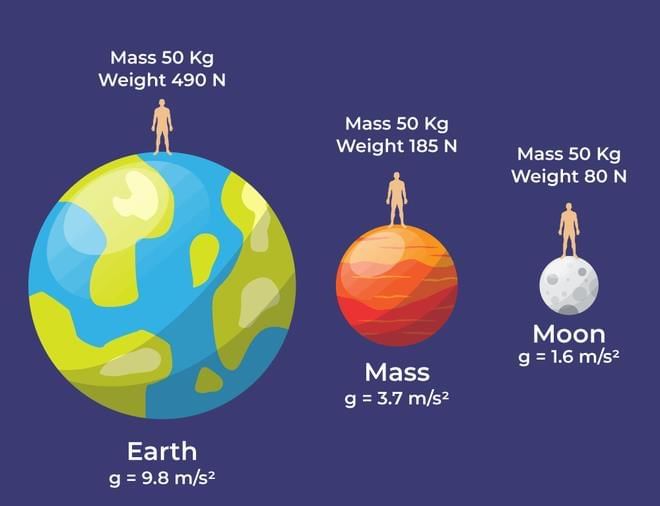
Everyday vs Scientific Language:
- In daily life, units of mass (like "10 kg") are often used to talk about weight (for example, "the weight of the wheat bag is 10 kg").
- Scientifically, this is not correct. The proper unit for mass is kilogram (kg) and for weight is newton (N).
- It is important to use the correct terms and units, especially in scientific work.
Buoyant Force: Upthrust, Floating, and Sinking
Upthrust (Buoyant Force) is the force applied by a liquid on an object in the upward direction. All liquids exert this force on objects immersed in them. Example: When you push a tightly closed empty plastic bottle into a bucket full of water, you feel an upward push on your hand and the bottle bounces back up when released.
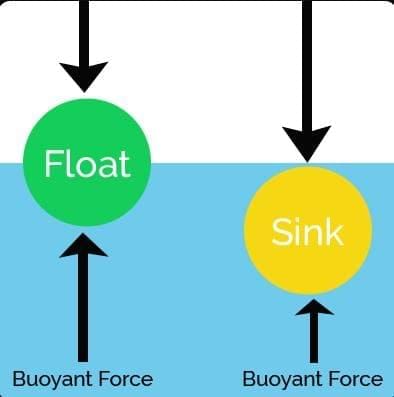
What’s Happening Physically:
When an object is placed in a liquid:
- Gravity pulls it downwards.
- The buoyant force (upthrust) pushes it upwards.
What decides whether an object floats or sinks?
- If the gravitational force (weight of the object) is greater than the buoyant force, the object sinks.
- If the two forces are equal, the object floats.
- The density of the liquid affects the buoyant force—a factor you will study in more detail in later chapters.
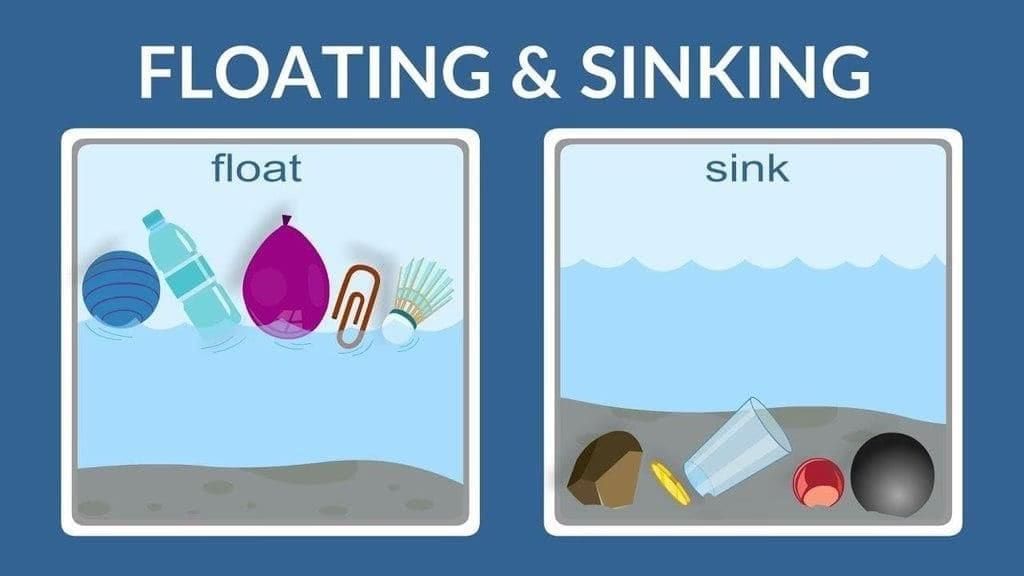
Interesting Fact:
Some rocks, like pumice (formed during volcanic eruptions), can actually float on water.
Pumice rocks are filled with holes and air pockets, making them less dense than water. That’s why they float!
Archimedes’ Principle
- Discovered by Archimedes, an ancient Greek scientist.
- Archimedes’ Principle: When an object is fully or partially immersed in a liquid, it experiences an upward force (buoyant force) that is equal to the weight of the liquid displaced by the object.
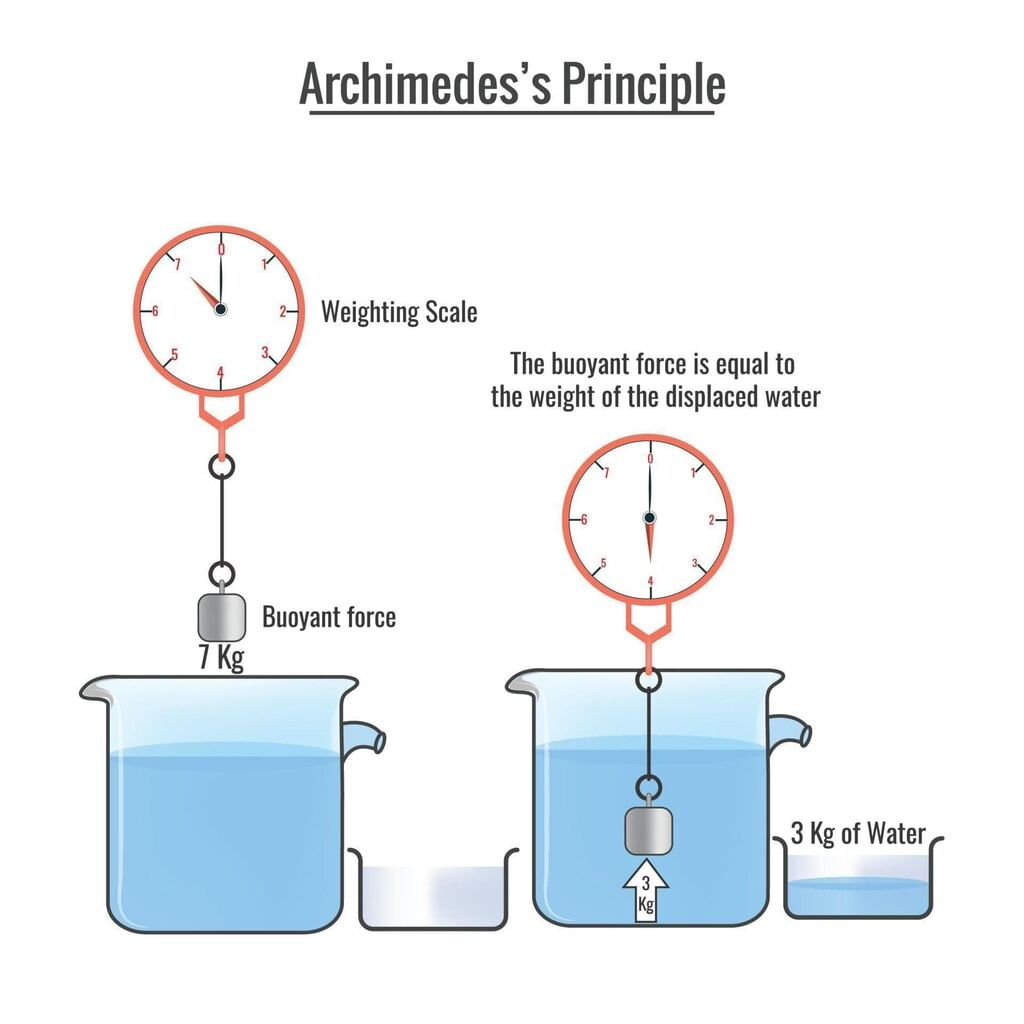
Consequences:
- If the weight of the displaced liquid is less than the object’s weight, the object sinks.
- If the weight of the displaced liquid is equal to the object’s weight, the object floats.
Key Points to Remember:
- Force: A force is a push or pull on an object resulting from its interaction with another object.
- SI Unit of Force: The SI unit of force is newton (N).
- Types of Force: Forces can act with or without contact between objects.
- Contact Forces: Examples of contact forces include muscular force (force by muscles) and frictional force (force between surfaces in contact).
- Non-contact Forces: Magnetic force, gravitational force, and electrostatic force are examples of non-contact forces (they act without physical contact).
- Effects of Force: A force can change an object's speed, the direction of its motion, or both. Force can also change the shape of an object.
- Friction: The force which comes into play when an object moves or tries to move over another surface is called the force of friction. Friction always acts in a direction opposite to the direction of motion.
- Magnetic Force: The force exerted by a magnet on another magnet or magnetic material is called magnetic force.
- Electrostatic Force: The force exerted by a charged body on another charged or uncharged body is called electrostatic force.
- Gravitational Force: The force with which the Earth attracts objects towards itself is called gravitational force. This force is always attractive.
- Weight: The force with which the Earth pulls an object towards itself is called the weight of the object. The SI unit of weight is newton (N).
- Mass and Weight: The mass of an object remains unchanged wherever it is, while its weight may change from place to place.
- Upthrust/Buoyant Force: When an object is placed in a liquid, the force applied by the liquid upwards on the object is known as upthrust or buoyant force.
FAQs on Exploring Forces Chapter Notes - Chapter Notes For Class 8
| 1. What is the definition of a force in physics? |  |
| 2. What are the effects of forces on objects? |  |
| 3. How are forces considered interactions between objects? |  |
| 4. What are the main types of forces in physics? |  |
| 5. How is weight measured and what is its relationship with gravitational force? |  |


